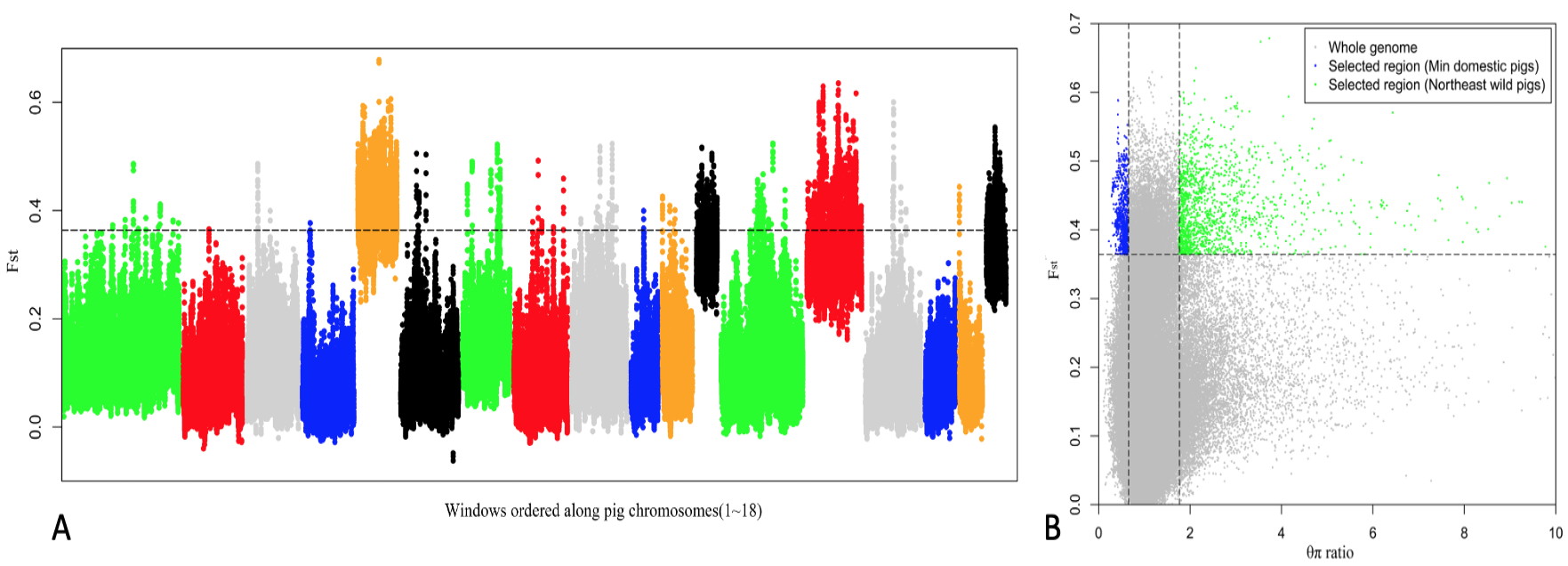Whole-genome Sequencing Reveals the Genetic Relationships and Selection Signatures of the Min Pig
Whole-genome Sequencing Reveals the Genetic Relationships and Selection Signatures of the Min Pig
Zhang Dong-jie1, He Xin-miao1,2, Wang Wen-tao1,2 and Liu Di1,2*
SNPs and InDels in the Min pigs and the Northeast Wild boars. (A) Numbers of SNPs and InDels in the Min pig and the Northeast wild boar. Blue represents Min pig and red represents Northeast wild boar. (B) Shared and unique SNPs between the Min pig with the Northeast wild boar and the pig dbSNP database (build138): 9,135,316 SNPs are unique in dbSNP138, 7,739,173 SNPs are unique in Min pig and Northeast wild boar, and 19,469,459 are shared between them. (C) The distribution of SNPs on the pig chromosomes. Blue represents Min pig and red represents Northeast wild boar.
Phylogenetic tree built using re-sequenced and previously published data. The numbers behind the name of each pig breed represent numbers of individuals. The numbers on each clade represent bootstrap support values. Sus celebensis, Warty pig in Sulawesi; Sus barbatus, Bearded pig; Sus cebifrons, Visayan Warty pig; Phacochoerus africanus, Common Warthog; Sumatran Wild, wild boar in Sumatra; South China Wild, wild boar in South China; Southwest China Wild, wild boar in Southwest China; Xiang, Xiang pig, another native pig breed in China; Tibetan Wild, wild boar in Tibetan; Min, Min pig; Japan Wild, wild boar in Japan; North East China Wild, wild boar in North East China; North China Wild, wild boar in North China; Meishan, Meishan pig, another native pig breed in China; Switzerland Wild, wild boar in Switzerland; Veluwe Wild, wild boar in Veluwe; France Wild, wild boar in France; Meinweg Wild, wild boar in Meinweg.
Principal component analysis (PCA). Each point represents an individual, and 80 individuals were divided into seven pig populations. Different populations are represented by different colors and shapes. Green represents Asian domestic pigs, blue represents Asian wild boars, yellow represents European domestic pigs, gray represents European wild boars, red represents Min pig, wathet blue represents Northeast wild boars, and black represents the domestic pig’s close relatives.
Selective sweeps in the Min pig and the Northeast wild boar. (A) θπ distribution across the pig chromosomes. (B) The ratio of Fst to θπ. The significant low and high θπ ratios of 0.728 and 1.367, and significantly high Fst values of 0.224 were used to screen the selected region of Min pig and Northeast wild boar. Blue points represent the selected region of Min pig, and green points represent the selected region of Northeast wild boar.














